A self-guided walk/bike tour of scenes from the last revolution to hit Lexington
By Guy Mendes
In contrast to the Greatest Generation, which saved the world from the Nazis and the Fascists, the crowd of students who hit their college years in the late Sixties was what you might call the Provocative Generation. They prodded and poked and pissed off a lot of people in order to help us understand that war was not the answer. They were part of a nation-wide movement not only because their lives were in the balance, but also because the American Dream had been exposed as a myth that hid the duel-headed beast of racism and militarism. These Provocateurs were in middle school or high school when JFK was assassinated. They were in college when MLK and RFK were gunned down. They were turning 18 when that meant, if you were a male, you could be drafted into the army and sent to Vietnam, where many people on both sides were being killed in a senseless, brutal war. They were just beginning to vote when Washington was burning and race riots consumed Los Angeles, Detroit and Chicago. And they were about to graduate from UK when they heard that antiwar protesters had been killed by National Guard troops on the Kent State Campus. Tin soldiers and Nixon’s coming, four dead in Ohio. It can’t happen here, right?
During the weekend of October 28-30, Lexingtonians are advised to be on the lookout for roving bands of hippie-dippie peaceniks, pinkos, radicals and bleeding heart liberals who have conspired to convene in Lexington during the last weekend of the month. This loose-knit band of sixty-somethings is re-grouping 41 years after some of them put Lexington and the burning UK Air Force ROTC Building in their rear-view mirrors. Others among them have been living here all along, quietly thinking their leftist thoughts, waiting for the next chance to march in the streets.
On Saturday, they’ll gather at the downtown YMCA (239 East High Street) at 10 A.M. for a walking/biking tour of their provocative past. Come join them on their tour, and afterwards head on down to Occupy Lexington to hear some of their stories.
Can’t make it then? No problem. Here is a guided tour of “the most dangerous moment in UK history” (so far). In the meantime, if you encounter someone Questioning Authority, or asking What’s so funny about peace, love and understanding?, approach carefully, flash the peace sign and say, Right On!
1. 1. The tour of insurrectionary sites begins at High & Stone. Not only is it a harmonic convergence of street signs and a good description of the Sixties, it’s across from the Downtown Y, where there are five yellow bikes available, thanks to director David Elsen.
2. 2. Go two blocks down High and turn south on Lexington Avenue. The spot where Sue Anne Salmon was arrested for burning down the UK AFROTC building was about halfway between Maxwell and Euclid, not far from the current Joe B. Hall Wildcat Lodge. Sue Anne was handcuffed on her porch and police confiscated what they said was a Molotov cocktail. One bystander yelled at her, “I saw you do it and I’m going to testify against you.” The next day front page headlines screamed COED ARRESTED FOR ARSON. Two weeks later, after a lab determined the bottle contained ginger ale, a small back page article said, Coed Exonerated. Sue Anne was a staff member of the blue-tail fly, so she later wrote a story about the ordeal.
It was a funny and frightening piece, about a five-foot tall, 100-pound shy person being falsely accused and mistreated by a system that presumed her guilty from the get go. (Copies of the blue-tail fly can be seen online thanks to UK Special Collection—the page pictured here is from issue number nine.) Sue Anne died in January, 2010. Here’s a thoughtful obit that ran in the Herald-Leader: http://www.kentucky.com/2010/01/16/1097860/courageous-advocate-for-earth.html
3. 3. Turn left onto the Avenue of Champions and behold the art deco beauty of the House that Rupp Built—Memorial Coliseum, scene of numerous national championships and a few significant protests. In 1966 it was here that William Turner, a black student from Lynch, in the coalfields of Harlan County, set up a one-man picket line protesting Rupp’s all-white teams. Considering the sacred nature of Kentucky roundball, this was an act of bravery. I’ve always considered Bill and his fellow Black Student Union members Jim Embry, Theodore Berry, Chester and Ann Grundy and P.G. Peeples to be the first real activists on the UK Campus. Four years after Bill’s singular protest UK integrated its basketball team.
Memorial Coliseum was also the scene of an unusual, mind-messing protest against racist Alabama governor George Wallace, who came to speak as a presidential contender in 1968. While protesters dressed in coats and ties and nice dresses demonstrated against Wallace, a large group of bell-bottomed, tie-dyed crazies called Hippies for Wallace picketed with signs saying things like “Turn On With George.” During his talk the hippies sat high in the rafters and cheered everything he said, such as how he’d run over draft-card burning protesters if he had the chance to. As the hippies’ cheers grew louder, Wallace finally looked up at them and said, “I guess they’re for us up there!” Nothing like a little political theater to stir up some national attention. Who knows, maybe it even cost him a few votes among diehard bigots.
It was somewhere in the vicinity of Memorial Coliseum December of ’69 that Don Pratt was arrested for contributing to the delinquency of a minor by having kids sell copies of the blue-tail fly, in which there was a photograph of a nude. Don was the circulation manager of the fly; he worked with Sue Anne Salmon, who wrote for the fly.
4.4 Ride to the end of the block in front of the Coliseum, cross Rose and look back toward the shopping center on the corner. That’s where The Paddock was.
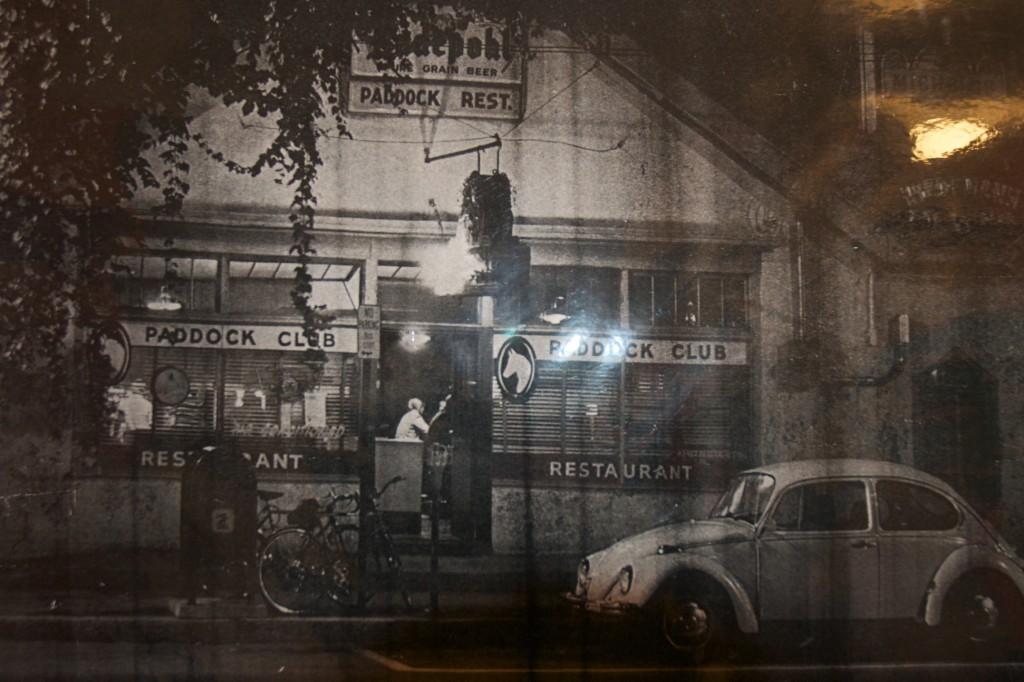
The Paddock, which stood at the northwest corner of Rose and Euclid. Photo from Lexington Free University archives.
It was THE campus bar back then. It was a place where who knows how many schemes were hatched, and then forgotten the next morning. If you look up and over the little strip mall, you’ll see a still-under-construction, three-story building looming on the horizon. This is the Wildcat Coal Lodge—$7 million worth of proof that the University has sold it soul to the coal barons, and sold out the people of eastern Kentucky who have to live with the devastation of mountaintop removal.
5. 5.Head back across the Avenue of Champions to the corner of Martin Luther King, Jr. and there, where a new dorm complex sits, is where the AFROTC Building burned on May 5th, 1970. Historian Carl Cone wrote in his book about UK that this was the most dangerous moment in the university’s history.
I disagree; I think it was a bit later that night, but more on that later. Meanwhile, I have to say that I did not burn the building. Nobody I know has ever told me they did it. I hear some people have bragged about doing it, but then disappeared from sight shortly after making their boasts. Forty-one years later it remains an unsolved crime, a real Lexington mystery. I think 98 percent of the people protesting that day were seeking peace, not chaos and destruction. I know for a fact that there was at least one undercover cop trying to get people to throw rocks through the windows of Beull Armory. And, obviously, someone did put the torch to the place.
Gov. Louie Nunn, sitting in a darkened car, is said to have watched the building burn and worried about the coeds in their pajamas who had to flee the adjacent Blazer Hall. He sent in the National Guard, equipped with live ammunition, to remove the protesters and cordon off the campus.
6. 6. Park your bike and go between the new Student Center and the old one, and you’ll see the grassy knoll where tear gas billowed, though billowed is not the right word, since Guardsmen were sticking the nozzles right in peoples’ faces, people like student government president Steve Bright, who along with many others, was forced to flee.
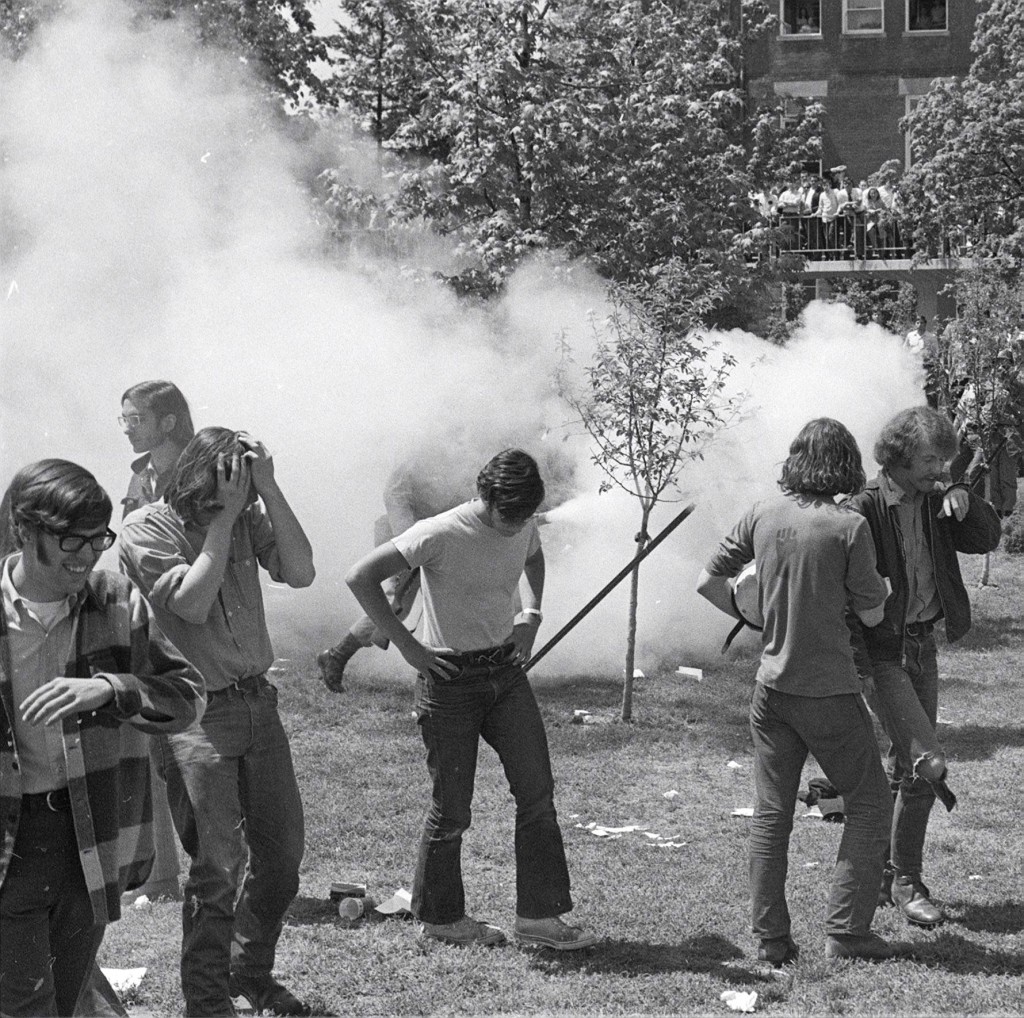
UK students move away from National Guard troops spraying tear gas on campus during a meeting May 7, 1970. Thirty-three students were arrested during the demonstration. Photo by Frank Anderson. Reprinted courtesy Lexington Herald-Leader.
While you are nearby, go to the top floor of the Patterson Office Tower and see where protesters were denied entrance to the Board of Trustees meeting, which was followed by a crush of people in the hallway and punctuated by former governor Happy Chandler punching a hippie, a grad student named Mark Greenwell.
Happy was roundly praised across the commonwealth, and the UK conflict intensified. Before you leave the P.O.T. top floor, check out the great view of Lexington.
7. 7. Get back on the bike and pedal over to S. Limestone and the Lexington Theological Seminary lawn. On your way you’ll pass the old Alfalfa’s, which is now a hookah bar (you can’t make this stuff up). On the seminary lawn you get a good look across the street at Memorial Hall, which played a prominent role in both of the uprisings of ’69 and ’70.
The first Student Spring was a protest over student rights. At the time the concept of in loco parentis ruled. Students—who were over 18 and could vote and be conscripted into the military—were not considered to be adults with the due process of the legal system accorded to them. So when four students were busted for having pot in their lockers and summarily kicked out of school one week before final exams, the campus erupted. The four students were never given a trial. They were deemed to be “clear and present dangers” and banished. Thousands of students protested.
They marched through the Administration Building, and then occupied Memorial Hall. It was called the Mother-May-I-Revolution because it was all very polite. The university allowed the protesters to march here and sleep there, knowing full well that they’d all be gone after finals. Fortunately for the students, the protests went on long enough to force the cancellation of finals. And sure enough, most of the protesters headed home. But at least they had put the university on notice. Authority was being questioned.
In the same spot on the night of May 5, 1970, one day after the Kent State killings, it could have happened here. Protesters were encamped for the night on the seminary lawn. The campus was off-limits, though no Guardsmen were in evidence. One foolish dude decided to test the curfew and ventured across the street onto the Law School lawn. Suddenly, Guardsmen came running out of the shadows, lots of them, toting their weapons, running toward the protesters. One Guardsman tripped on a landscaping guy-wire and he fell forward, his gun pointing toward the crowd. He landed on his stomach with his gun stretched out in front of him. He did not fire, but it was clear to those who saw it that someone could have died if that Guardsman had pulled the trigger.
I vote for this as UK’s most dangerous moment. What if you knew her and found her dead on the ground? How could you run when you know?
8. 8. Now head across Limestone to the big curved driveway leading to the Administration Building. When students converged here in ’69, they were angry about being ignored by UK officials, who were justifiably leery of addressing a revolutionary throng. For some of the demonstrators, marching through the building in orderly fashion was not their cup of tea, so they resorted to symbolic action, rocking the cannon out front loose from its pedestal and turning it to face the Administrators. When the Dean of Students did venture out he turned ashen and sweat popped off of his bald head. He muttered something about how it looked like the storming of the Bastille during the French revolution and he quickly retreated. This Question Authority thing was getting out of hand.
I suspect that not long after that incident the university had the cannon cemented back in its original position.
Wouldn’t it be great if it were still moveable? How many re-enactors would it take to turn it now? Where would we point it—toward the Wildcat Coal Lodge, perhaps?
9. 9. You’re in the home stretch of the tour—ride back to Martin Luther King, Jr. Drive, formerly known as Harrison Avenue. Head downtown and you’ll be following the path that the major anti-war demonstrations followed to get to Main Street.
The crowd was usually led by a former Marine who had fought in Vietnam and had witnessed things that tormented him. His name was Michael Lane. He was an art student who made silk-screened prints of a bleeding American flag. He also built a beautifully crafted wooden sign, a kind of totem really, that he carried in every march. It said,
“Michael Lane,
he’s insane,
he killed for peace
that never came.”
No word on Michael Lane’s current whereabouts. Michael, call home!
10. Cross the viaduct, check your brakes as you coast down to Main Street and hang a Ralph to visit with the Occupy Lexington protesters on the corner of Esplanade, outside the J.P. Morgan Chase Bank, which was one of the bad actors in the sub-prime mortgage meltdown. (They recently paid a $153.6 million dollar fine to settle a federal suit that alleged that JPM Chase stacked the deck so that they profited even when their investors lost money.} The current crop of protesters, who’ll be 40 days into their occupation by then, will be glad to see you. Grab a sign and make some cars honk their support.
For the last leg of the tour, ride down Main toward the old courthouse, the one where Clean Gene McCarthy, the peace candidate for president, addressed a big crowd of supporters in 1968.
Remember how back in 1970 you marched down Main Street with hundreds of others, letting your freak flag fly, chanting One Two Three Four We Don’t Want Your Fucking War.
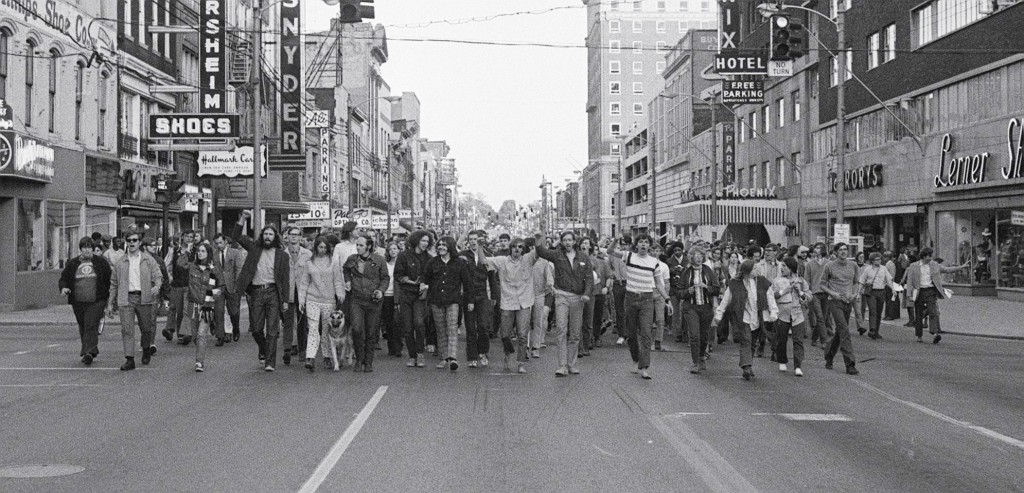
UK students march down Main St., Lexington, KY May 6, 1970 after being forced off their own campus enroute to Transy campus, where they held a peaceful rally. Photo by Bill Hickey. Reprinted courtesy Lexington Herald-Leader.
Remember how that war seemed to drag on and on, but it did eventually come to an end five years later, in large part because of a change in public opinion. While several national demonstrations called “moratoriums” helped to turn the tide, it was the countless local protest marches—boots on the ground in places like Lexington—that helped bring the troops home from Vietnam. You can be proud of that, while at the same time recognizing that the peace movement still has plenty of work to do in the here-and-now.
Full disclosure: Guy Mendes was one of the founding staff members the blue-tail fly, which published 11 issues between 1969 and ’70. Drop on by UK’s Special Collections Library and learn some of the region’s radical history. A full gallery of Mendes and archival photos accompany the online version of this article, found at noclexington.com.




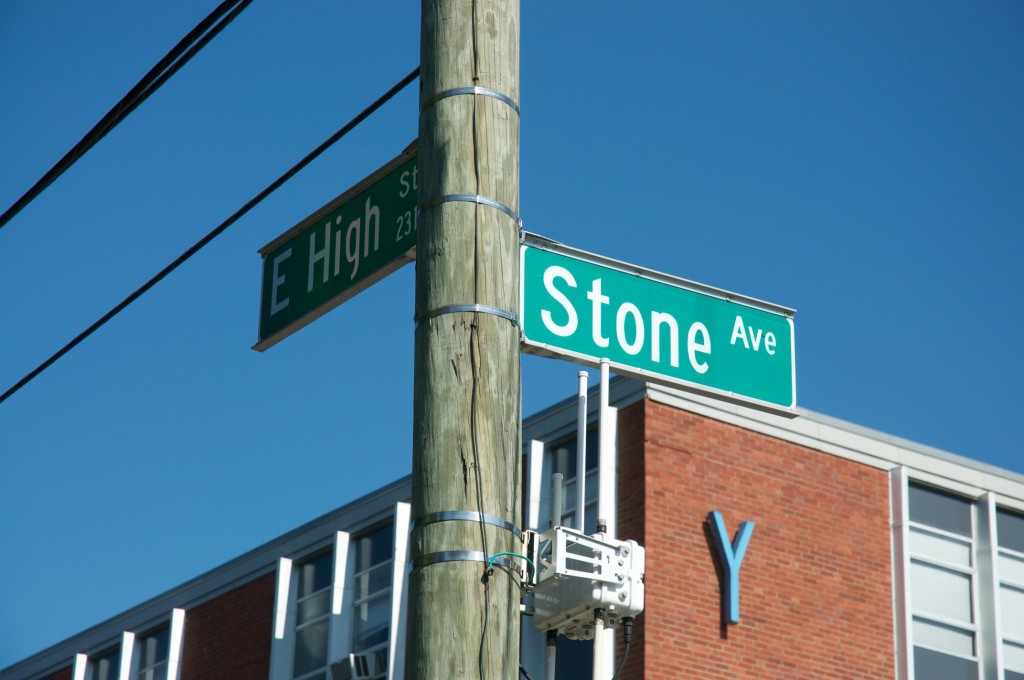

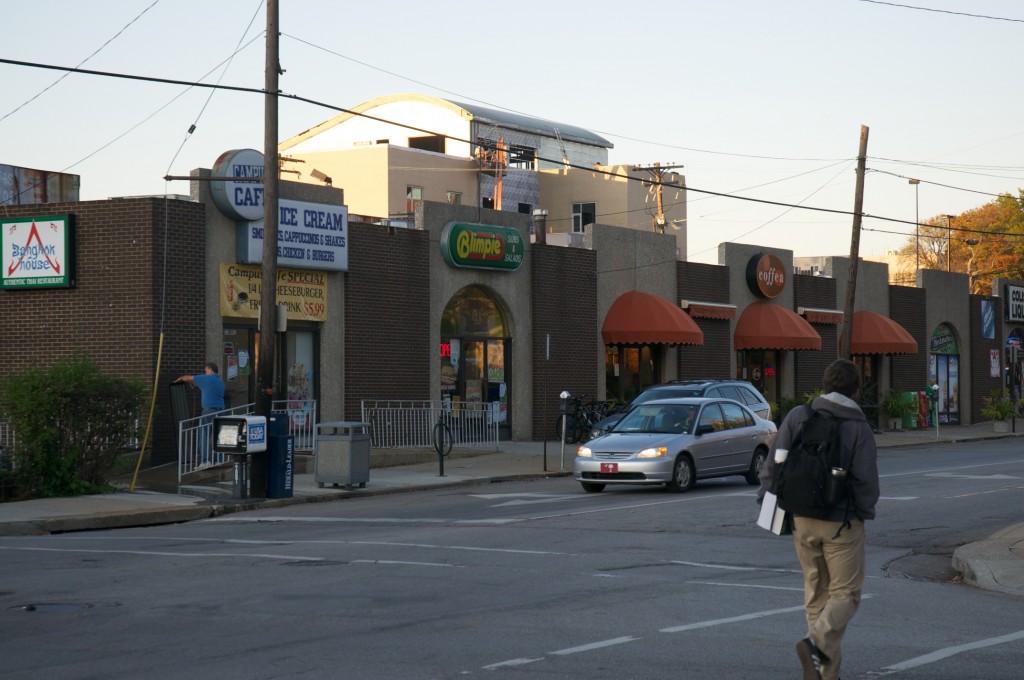

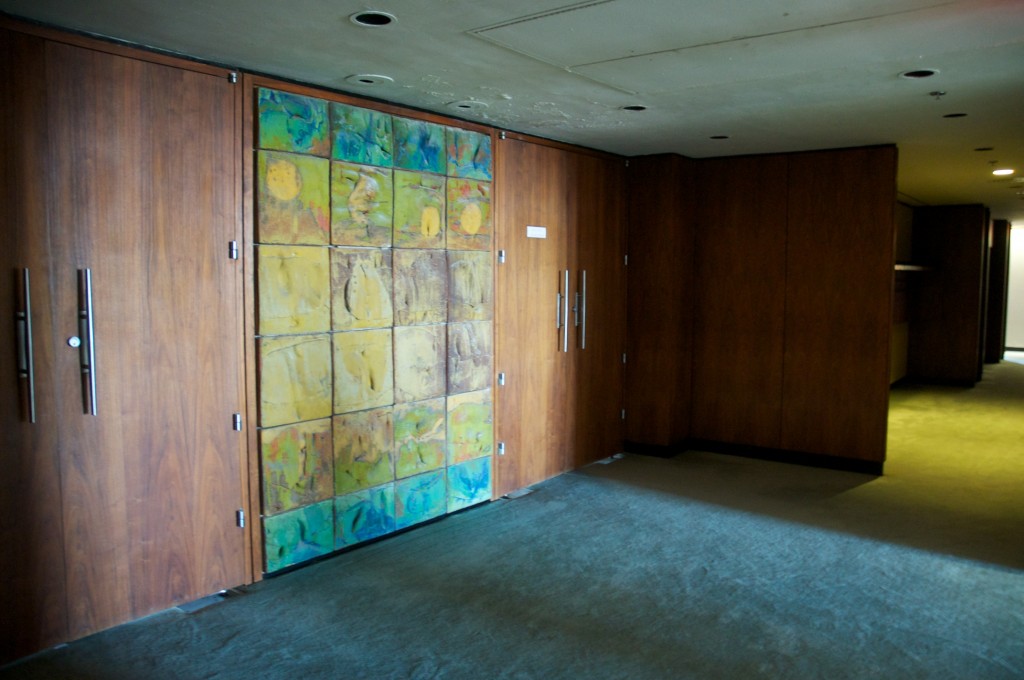
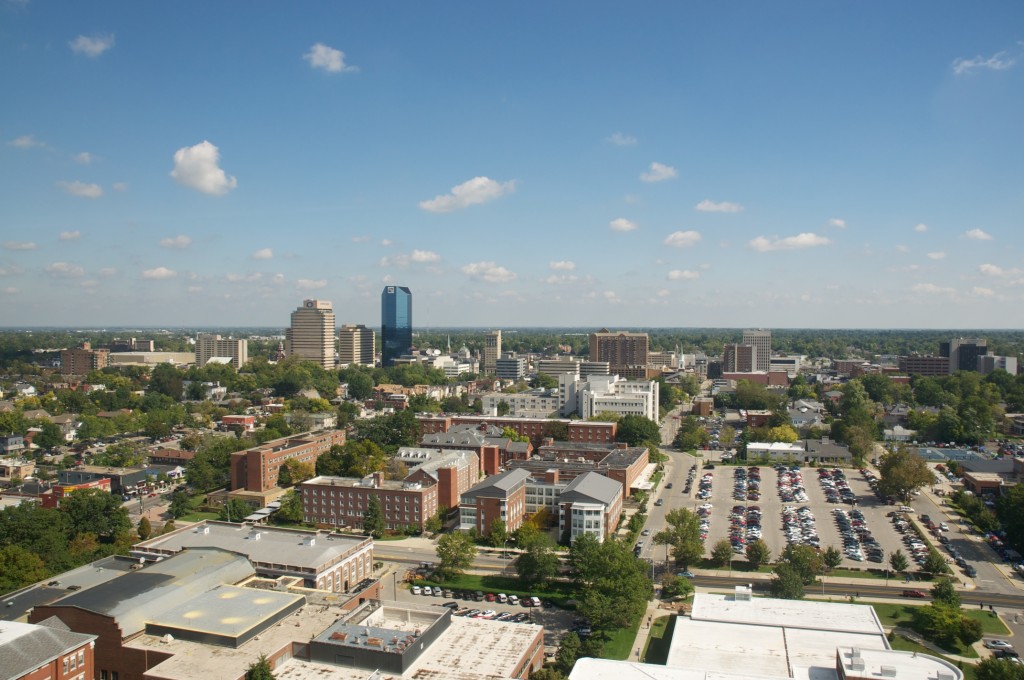
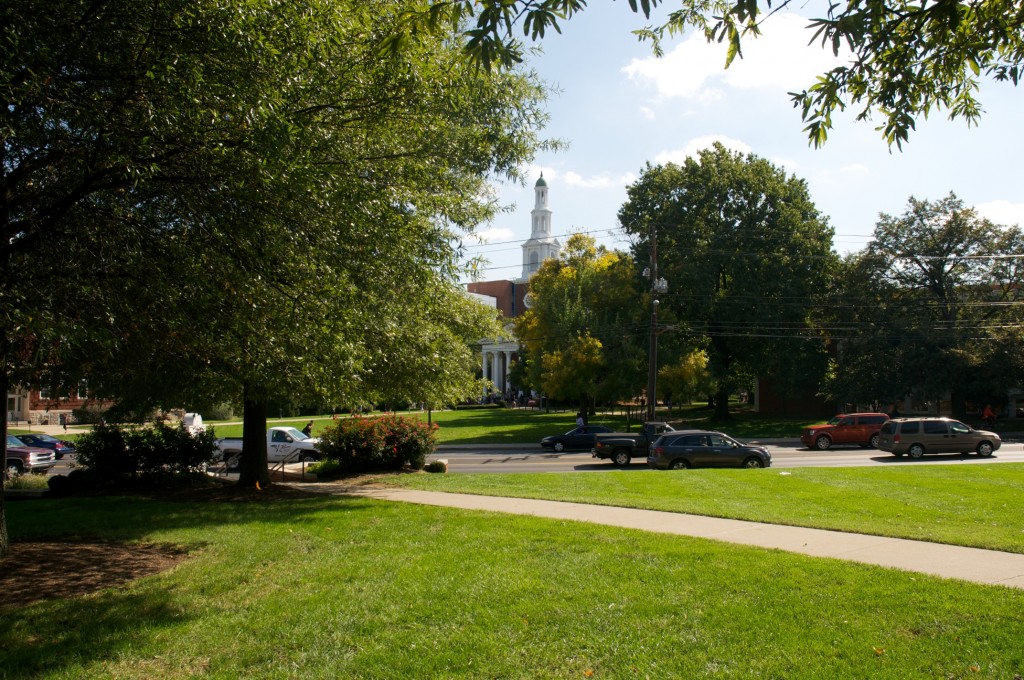

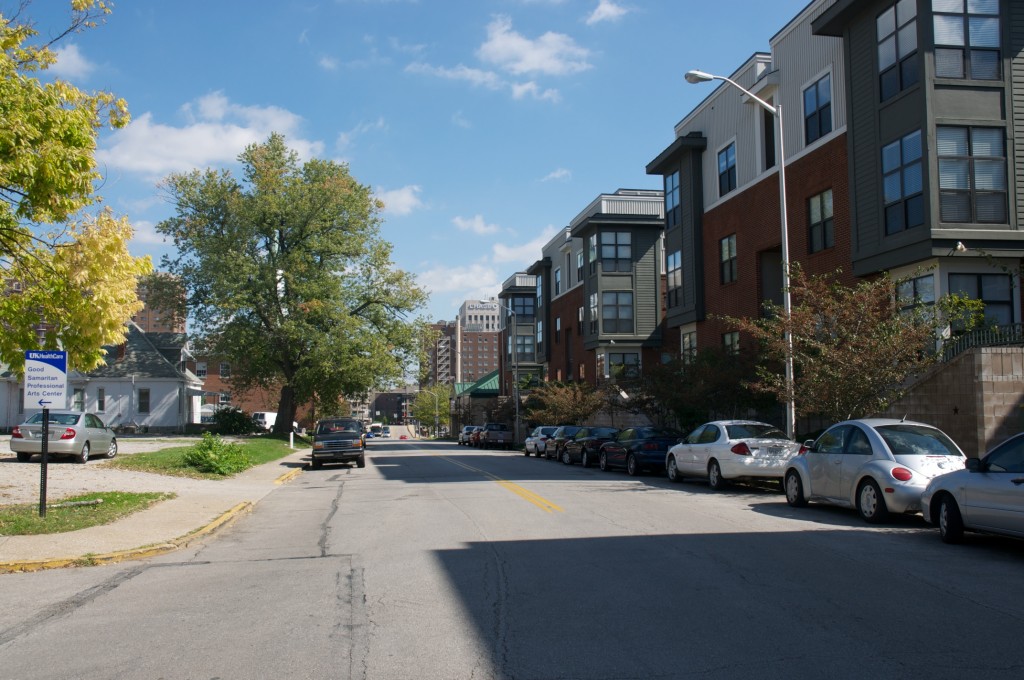
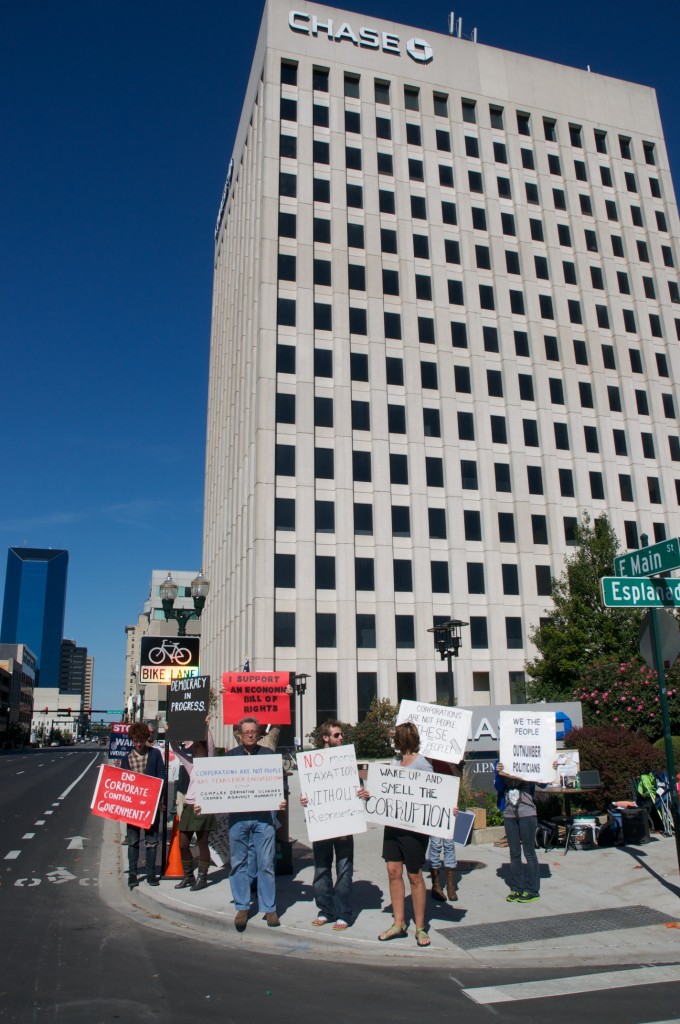
larry godhelff
genius!! thank you!!
Don Pratt
Not sure if any of you want another inside observation of ongoings, I was there for almost all the ongoings. It included seeing Guy at the protest to try to get the Board of Trustees to support students as well as oppose the war because of costs to students, university fundings(war instead of peace) and lives lost in Vietnam and at Kent State.
Don Pratt
The most dangerous moment in UK history
https://noclexington.com/the-most-dangerous-moment-in-uk-history/?fbclid=IwAR3Ss4jzNJYBHTanX-54GijVu5aZB96wVuFG329LqMddhPc4Yw9qCba5Zsw
And the reason I was arrested for the Blue Tail Fly incident (Guy Mendes’s editorializing) was a collection of events.
The staff of the Blue Tail Fly failed to sell enough copies, and ads, to pay for printing so I made numerous efforts to sell issues and pay off what I remember to be at least $500 debt.
(I eventually did raise that much by selling a huge number of copies outside the Atlanta Pop Festival gates) and gave that to Guy Mendes and Dave Holwerk, later editor of the Lexington Herald. Seems the two of them took the money and also decided not to print anymore issues.)
I had been a newspaper carrier of three Lexington Leader routes as my independent work before, during and after college.
Over the years, numerous little boys would help on the routes and spent the night. Many of them showed up at my wedding on one of the routes in the Castlewood Park barn. And after being married, many of them spent the night on mattresses on our floor.
One night, night they spent the night saw the bundles of unsold papers.
I suggested that they could make some money selling them nearby outside the Memorial Coliseum which they did.
Making money they stopped in the grill next to UK basketball stadium.
On the stools in the small grill sat Lexington Police who looked at copies.
Inside was the artistic nude photo, I think by Guy Mendes.
The police inquired how they got the papers and from whom.
Immediately, the police acted filing charges of contributing to the delinquency of minors, plus taking the kids home before coming to arrest me.
Charges were dropped outside Fayette County courthouse where nudes surrounded a pole in the front yard.
UK’s fabulous civil liberties defense lawyer, Bob Sedler, represented me… no help from the Blue Tail Fly, Guy Mendes or David Holwerk.
Guy was one of the leaders of the Mother May I Revolution that began because of double jeopardy of punishment of students found receiving UK penalties before being found guilty by the courts.
Note, the idea of turning around the cannon outside the Administration building was my own. With the help, I think of Guy and others, we turned it around twice.
The second time, artist painted colorful peace signs and slogans on it.
Guy shared the idea of the first “Hippies for Wallace” who came to UK at Memorial Coliseum. He didn’t participate but covered it, seeing it make national news?
And Sue Ann Salmon was a roommate of Kathy Pratt and I, and personal friend.
John Y Brown, Sr. defended her poorly as she should have been able to sue UK for false arrest. After Sue Ann’s funeral, her family told us, a group from UK, who burned the building. They shared the name that Lexington’s fire department gave them.
Judy Schroeder
Thanks for the update, Don. As a frosh & soph those years, I was mostly at the back of those crowds, but there during the tear gassing (just out of frame in that picture), and played “the coed” who incidentally stopped Happy Chandler to talk as he left the Board of Trustees that day at Patterson Tower. The main hall to the elevators were being guarded against intruders, but the side hall to the water fountain & Board Room doors was wide open. It was just a coincidence that I was standing at that door when Chandler came through, and, while campus police were in front of him to block the crowd, it was a chance to step up & ASK Why the Board ignored our case for divestment. By then, the guards & Happy were surrounded. When Happy dismissed me with a pat on my cheek (he really did that), Mark reached foward as imitation. him in the same gesture. I’m not sure he touched him, but Chandler looked up, realized it was a long-haired hippie, & thought he’d land a punch! Which he did. Ahhhh, the good ol’ days of the Peace Movement.
Don Pratt
Wonderful to hear first hand! false story/”fake news” account by some/most
media!
Don Pratt
Wonderful to hear first hand! false story/”fake news” account by some/most
media!
AS TOO UK DEMONSTRATIONS, and my memories:Guy Mendes had one of the leaders of the Mother May I Revolution, the year before. Those demonstrations were because UK was penalizing students before being found guilty of any crimes by the courts. It also was double jeopardy by punishing students.The leaders spoke on the steps of the Administration building.We were let in to walk single file into the first floor and up the step to the second floor and back until some fool started putting the rest of his ice cream on the wall.I heard that that night, one student may have placed match sticks covered with apoxy in the exterior locks. Were all locks changed?Note, on another day and time the idea of turning around the cannon outside the Administration building was my own. With the help, I think of Guy Mendes and others, we turned it around twice. The second time, artist painted colorful peace signs and slogans on it. And at another time and place, Guy shared the idea of the first “Hippies for George Wallace” who came to UK at Memorial Coliseum. Guy didn’t participate but covered it, seeing it make national news?As to the woman charged with the fire, Sue Ann Salmon was a roommate in our house with my ex wife Kathy Pratt and I. In court, John Y Brown, Sr. defended her poorly! She should have been able to sue the police for false arrest. All she did was walking to her Lexington Ave. home from the Convenient store on Lime and Euclid. She was carrying a couple of Ale81 bottles as she passed the abandoned Air Force ROTC building that burned.As a personal friend, Sue Ann came with my then wife, Kathy, to Milan, Michigan to tell me that my dad had been killed in a petty robbery. I was in Milan Federal Correctional Institute for resisting the Vietnam War and draft. I was released 12 days short of coming home normally. Years later after Sue Ann’s funeral, her family told a group of us from UK who actually had burned the building. They shared the name that the Lexington’s fire department gave them.The recent posts on UK “riots” again came after the killings at Kent State. But most never heard about or know that days before of other killings of anti war students. These came at Jackson State, a black college.But the post’s reminded me, or my own experience, as did some newspaper writings about Lexington’s and University of Kentucky’s protests.
A few folks have asked me to write them down.I recall well a photo of one beginning event that I have seen hanging in the entry way of UK’s WTYoung Library on the left. Note: WTYoung’s daughter asked me to speak to her Sayre School history class. I did. Sayre faculty was upset so they later scheduled a military spokesperson. So sorry we didn’t get to debate! The photo in the UK library shows Nancy Scherr and others carrying a casket toward campus down the Avenue of Champions.My first memory of events on the UK protest on campus was of protesters – students, faculty and others – “occupying” the top floor of the office towers.The Board of Trustees also were meeting and the desire of protestors for the board to address the Vietnam War, the draft, the costs and effects on students, the UK budget with money going to war and dangers of Kent State possibly happening on campus.Hearing students did not happen and our thoughts were not shared by us with the Board that showed no concern. But one notable incident did happen besides UK’s President Otis Singletary eventually “sitting with students.” It was then that he, being a history professor before, faked interest and talked of setting up a “forum” in Memorial Coliseum. I think a student center ballroom forum may have occurred but I can remember attending.The most notable incident happened as police escorted former Governor A B Chandler to the only operating elevator to the top floor. Other elevators had been cut off to the top to stop more protestors on the top floor.As Chandler passed a student, Judy Schroder spoke to him. Chandler turned and petted her on the cheek saying something like,”Young lady. Someday you will learn.”Hearing this and standing nearby Michael Green, another student, tapped Chandler on the cheek and said something like, “Old man, maybe one day you will too.”Chandler grabbed his hair and punched him then was moved onto the elevator by police and left.Afraid, Green didn’t press charges of assault. He was on probation for marijuana charges. After all, his marijuana charges came because the infamous Drew Thornton, Lexington police detective turned dealer, wanted him to sell Drew’s provision of harder drugs.(Remind me to tell a true story about one of A. B. Chandler’s escorts, a pedophile.)
Confusingly to me on the timing, the march thru town occurred when? That march to Transylvania University was to be a photograph that represented much to many who recall the Lexington Vietnam protests.With a couple of Vietnam vets amongst the group parading, we passed the Fayette County courthouse. The courthouse, pubic property, may have been where leaders were headed.On the steps of the courthouse stood two men with submachine guns, protecting the premises. One was the infamous county detective Henry Vance. Henry later was charged with providing the gun to Lexingtonian Mike Kelly’s wife who then killed a Florida Federal prosecutor.(I was called Henry Vance’s Federal trial in Ashland to testify. He used telephones on the side of the building of my Woodland Grocery, on Woodland Ave. In a coincidental meeting after his prison stay, Henry threatened to kill me.)Marching on beyond to Transy’s campus, protesters gathered on the Transylvania’s Morrison Hall steps.National Guard following us pulled up at the driveway to this part of the Transy campus but their Dean of Students or President or some staff member welcomed us.But one of them also told the National Guard, that had arrived, that this was a private campus and they weren’t needed.After a while, the gathering and leaders decided to return to UK. That may have been to have the protest in front of the UK Army ROTC Armory building later.
Outside the Armory was when the only crime by students occurred. Graduate student Mason Taylor threw a rock at the ROTC building, maybe breaking a window?He was the only one found guilty at the trials of students. He actually plead guilty. (Another story will be told about the trials soon.)Humorously a group of totally unfit, UK Police in “riot gear” stood between us and the ROTC building. While sitting quietly Nancy Ray, in the Dean’s office, personally told me that the police were out to get me. When police came up from behind what I thought would be swinging clubs, I easily escaped thru the Student Center as I grew up on campus as well as unsuccessfully attended university far too long.Before then, John Junot, a well known yet “interesting” student in 60’s UK history, and Al Cole, who we found out to be an agent provocateur, broke into the UK Women’s gym.he gym was part of the same building to the left of the Army ROTC Armory. It was easily understood, John wasn’t competent to pick locks!As John screamed that he had found secret “Army files,” I took off running to get them out of there and explained that they were in the women’s gym. A few of us later overheard Al Cole, the undercover student, telling media that Dayton Black Panthers were on their way to Lexington to defend protestors. So we decided to set up a press room in the card playing room in the basement of the student center. That was where I was when 4 or 5 huge UK football players showed up, demanding the large, homemade peace symbol flag/bedsheet that hung between dividers to the room.John Crump and Lew Coulter jumped in front to defend the flag posed like they knew karate. I quickly jumped facing them with football players at my back and said, “We don’t need violence to keep a flag!”Thankfully, John and Lew backed off. The players, who apparently was led by another Chandler to beat heads. That Dan Chandler later became a Casino operator in Vegas. I was told that the flag was afterwards seen in a state police car nearby.The fire – that Sue Ann Salmon was falsely accused of – occurred while we were writing and typing press releases. Lots of news media was getting only the university side of the story. We were telling the truth!Things broke up on the hill with the fire on the other side of the building.One student was to tell me of his watching the fire as a car with darkened windows sat in front of him.The window rolled down and Louie Nunn smile unhappily at him. He took off.The student’s mom was a personal friend of Louie and a Republican big wig.That student never told his mom but years gone by he found out his mom knew but never said a word to him.The next day was when most of the violence by the police and National Guard occurred.
A protest forum was happening in the “free speech” area between the student center and the women’s gym.Can’t remember speaking much, but one of my roles was to induct humor in these tense situations. (I even did at the student trials.)I was asked to read a newspaper ad I carried in my billfold. I’d love to have the ad still. With a country, mountain accent I said, “You may have worms and not know it. “Round worm, flat worms, hook worms, tape worms. “Your family may have worms and not know it.”I did read more of the ad as it went on including the name of the product and contact information.The ad brought laughs numerous times. “Supervising” police and UK officials broke smiles as well.At some point when I looked up, the National Guard was rolling out tear gas to begin spraying. Pat White, a graduate assistant in English, and my own Anthopology prof were sitting there in the misty spray, maybe to be arrested additionally.That’s when I remember leaving with a large group of students toward Euclid, then toward Limestone while police began arresting students including the Student President who had joined the protest.One student, Peter Mitchell, who later was a conscientious, United Mine Workers advocate lawyer, was getting a beating, too.We were being escorted by police and then walking beside the old men’s basketball gym, now part of the student union.One loud mouthed friend of Al Cole, Steve Swartz, saw the beating of Peter Mitchell yelled, “Pigs” then more profanity. A police yelled get him as he attempted escape but accidentally jumped down the hill into bushes. Steve turned raising his hands yelling, screaming as well as crying, “Please don’t hit me!” “Please don’t hit me!” They took him away. I never saw his afterwards though I have heard of behavior and crimes he and Cole later committed.Continuing marching to the Lexington Seminary, protesters arrived there for some to spend the night.On the Seminary lawn, the crowd grew and grew. We were even joined by UK football players who said they were seniors thus they could speak in support. They also said that there were many non seniors that supported us but couldn’t be there in support.We had a line of Lexington police in front of us on the sidewalk in front of us. This was while National Guard, across the street, began placement hiding in the area in front of Memorial Hall and the law school.I believe the Faculty Senate had been meeting in the Law School Auditorium where they called off classes for the year.My only memory of speaking to the protesters there was identifying two FBI agents on the campus side of Limestone. One stupidly was trying to hide behind a telephone poles. He was the dumb one of the two. The good guy waved.As night set in the crowd got smaller so Lexington police left. Many folks went home to get sleeping gear and returned, setting up tents.Drew Thornton and another narcotics officer showed up and came thru the bedded downed crowd. Across the large lawn, one could hear a chorus of,”NARC!” “NARC!””NARC!” Nothing was done by the narcs despite the strong odor of marijuana.Later wide awake a few of us began to think of challenging games to play.One became first game, our first and only. Why?We decided to see who could run the farther distance onto the closed campus before getting caught.A healthy, lean and clean track student volunteered first.He took across the street running across Limestone and into the grass lawn heading toward Memorial Hall, symbol for UK.He “got a long ways toward.” But immediately out of bushes came National Guard to catch him.Unbeknownst to us AND THE Guard, a small dark wire had been placed to keep people off the grass during normal days.One guardsman hit that wire and flipped in full gear as the track star turned and ran back.That was the last memory of the night.The next day many of us campers crossed back over Limestone to walk back to the Armory while asking questions of the KY National Guard members.
David S Perry
To clarify Don’s comment “Charges were dropped outside Fayette County courthouse where nudes surrounded a pole in the front yard.”
For those not familiar with Lexington’s old courthouse, the nudes are sculptures of children around a pole (not real live nudes at the time of the incident).
Peck Kennamer
Holy Cow!! I just stumbled on this article and what a rush of memories. Like most of you I was involved in much of the anti-war activities at UK (President of Student Mobilization Committee, etc.). It was a tumultuous time on campus, one that unfortunately distracted me-and perhaps others- from my studies. As the years have passed(God, where did they go?) I’ve reflected on the whole affair. I have no doubt that for most of us involved we were driven by a sincere belief that the war was a colossal mistake-and we were right.
For those interested I live in Louisville and practiced law for several years, I have a wonderful wife (attended UK) and a son that just graduated from Sewanee and is headed toward law school as well.
I guess while I’m rambling on I’ll relate the story of how I found this site. Bob Walther, Franklin Owen and Doug Stewart (?) and I were in the concert business together when we graduated. We promoted a Uriah Heep concert at UoL’s Parkway Field Saturday, July 21, 1972 (opening act ZZ Top). That is today’s date and it prompted me to do a Google search of these guy’s names and here I am! These new fangled devices are amazing!
Linda Bailey
OMG. I can’t believe I just found this article! Not only was I at UK during the “Mother-May-I” revolution, I was very involved. I was on student government and ended up dropping out of Chi Omega sororiety when the housemother slapped me for voting to end the playing of Dixie at football games. (Yes, they really did play Dixie!) Guy Mendes, Sue Ann Salmon, Betty Ann Carpenter, Steve Bright, Bucky (now goes by Estill) Pennington, Don Pratt, and so many more that I remember so well from those turbulent years. I do so wish I had know about the October 2011 reunion! I would have certainly been there. I have so many stories to tell that only folks who were there and involved would appreciate. Guy, thank you so, so much for this wonderful article. It brought back so many memories. I cried AND laughed at the same time as I read it. Given what the country is going through right now with Cheeto Head, a new revolution is in order!
Galen Bailey
Bob Walther is a personal friend and I am talking with him at this very second (Tuesday evening 9:50 pm 3/28/17) about his friends in the photo that was in the Herald Leader Newspaper. Bob is the kid in the center of the photo with his head down walking away from the tear gas.
Galen
Henry Brazzell
I was finishing my years at U.K. in Spring of 1969 and was involved in that protest. I do not remember finals being cancelled. In fact I had mentioned re-occupying the Student Center for a study-in to Don Pratt, but I never followed up on it. I do remember “being allowed” to occupy the top floor of the Student Center on a Friday night. Was student teaching at Henry Clay that semester so missed most of the daytime activities. I did end up on front page of Cincinnati Enquirer the day after we surrounded the President’s house. Ironically, at the time of the 1970 protests, I had been drafted and was in riot control exercises at Ft. Hood Texas.
Don Pratt
“study-in Don Pratt”???
Don Pratt
Not sure if any of you want another longer inside observation of ongoings, I was there for almost all the ongoings. It included seeing Guy, who I think was with the Kernel then(?), in the room at the Office Tower protest to try to get the Board of Trustees to support students as well as oppose the war because of costs to students, university fundings(war instead of peace) and lives lost in Vietnam and at Kent State.
Robert Walther
Not that it matters now, but the guy in Center of ‘Tear Gas’ pictures is me , bob walther aka the ‘Silver Bullet’. I can verify by the belt buckle and the silver Accutron watch. IF I remember correctly. Doug Stewart, myself, Julian ‘Peck’ Kennamer and one other were arrested near the Central Campus side of the Student Center after being blinded by Pepper Fog.
Peace Love and Revolution
Not necessarily in that order…
D P Stewart
Hey, Bob, this is Doug Stewart. Long time, no see!
Bob Walther
Doug,
I have not checked this site in a year or so. Please contact me…Lots of stories and grandchild #11 due soon. .
Bob Walther
rgwalther@gmail.com
gene hancock
great account, I was there for all of it and its accurate, the Blue Tail Fly was the ointment that severed the generations, I sent a subscription to My father who needed to soften up a bit, he was Archie Bunker…he cancelled it and let me know about it, with a few unkind epithets
Robert Walther
Hey Gene,
bob walther. Hope you are doing well. I now have 8 children and 9 grandchildren. Been trying to find Doug Stewart. Congential Heart defect cut me down 10 years ago after working as a multimedia contractor for P&G nearly 16 years. Two open heart surgeries, recently a pacemaker implant and Stage IV Renal failure. If you would, please answer, time is shorter every day.
Don Pratt
GENE, I have too many memories and am even trying to sort out events of UK protests.
1st rally was outside the office towers, then up to the top.
I even remember us going to get information on the Lexington politician’s arrest where your grandfather was county judge? and of course your hospital stay.
As to the rally in front of the Army ROTC building… did it occur the day of the fire, but when was the march thru town? Earlier that day?
Another rally, maybe the next day (?) was next to the student center where and when the National Guard gassed folks and demonstrators marched to the Seminary grounds for the night.
Hello and due call sometime. Hello to Terry, too.
Rose St. Clair
I was there, it was really remarkable how many brave and noble people there were! I’d love to be there for the reunion march! Thanks for this article!
Teresa Cole
It wasn’t just UK students. There were students from several area colleges and universities, including friends from Berea College. The idea was to generate numbers of one mind all together.
This is a wonderful tour you have created, Guy. Thanks.
Don Pratt
Glad to see this! You were defined as outside agitators… as was I a former student, who grew up on campus since dad was the purchasing director and had as employee on two jobs. My lung collapsed on the final one, an architectural work.
Mike Meadows
I was there, involved in what was supposed to be peaceful protest, but one which erupted into a violent standoff between students and national guardsmen in riot gear behind the student center. We were listening to rally speakers when surrounded and attacked with teargas, billy clubs and butts of rifles with bayonets fixed. I saw it, couldn’t believe it was really happening. I crawled into some nearby bushes, with my friend to escape the assault and we made my way back to our fraternity house. I saw the ROTC building burning that nigh. We were hearded onto the seminary lawn as a safe haven the next night, where we camped and held a candlelight candle vigil, while surrounded by police and guardsmen. It was somewhat tense, not knowing if they were going to assault the protesters again, but everything ended peacefully the next morning…just a bunch of idealistic, college kids thinking we could force the “establishment” to listen to our contempt for a “military action”, as it was called, that we didn’t want to die in …it happened, as this article says. Then we all had to grow up, get jobs, pay taxes…and become the establishment!
Don Pratt
Glad to hear this from a respectable fraternity member (:>). I shared a longer version of events and still need to go back thru Guy’s account.
Laura Calkins Mollett
I remember marching for this. I was 10. My father was a UK professor (and we were, and are, bleeding heart liberals). My younger brother was 5 or 6 and my father carried him on his shoulders. There was someone who could juggle and tried to teach my brother. We went up Woodland and around Clifton Park, then back toward the Student Center though – that portion isn’t on this list. There were a lot of people and I believe I thought it was more like a street fair than a protest.
Don Pratt
Your dad’s name? What did he teach? How many in the group?
Aisha
i am so proud of them, peace is what the world needs
Sheila Strunk Pyle '53
I’m so proud and grateful for these students who risked their lives and college degrees and reputations to march for peace and fairness. We are a blue nation after all.
Jake
I protested the war, but in retrospect I think the bulk of the protests were against the draft more than the war. Notice the silence, especially by the old protestors, against the wars since Vietnam. Obama was lionized while prosecuting several wars at once.